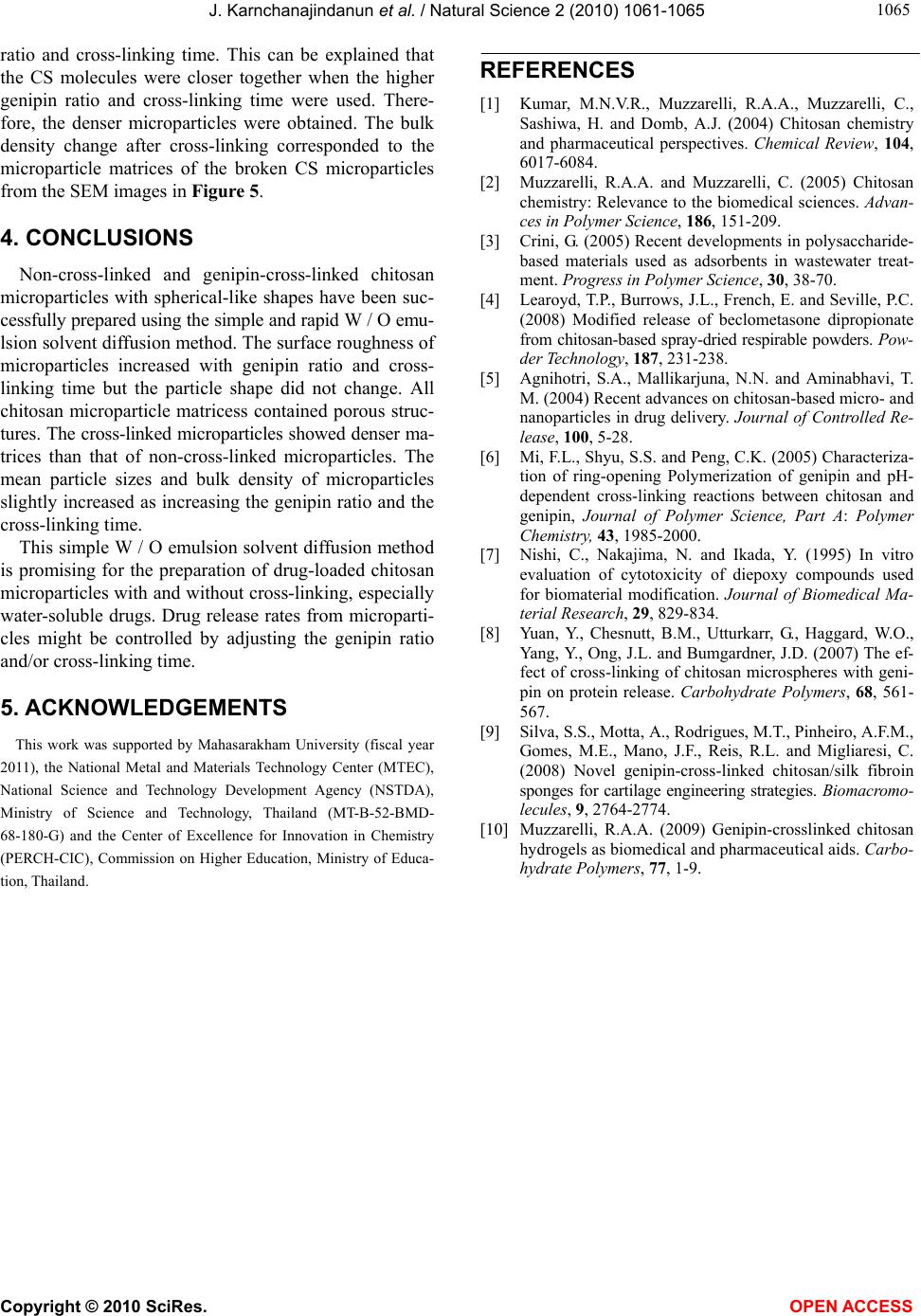
J. Karnchanajindanun et al. / Natural Science 2 (2010) 1061-1065
Copyright © 2010 SciRes. OPEN ACCESS
106
1065
ratio and cross-linking time. This can be explained that
the CS molecules were closer together when the higher
genipin ratio and cross-linking time were used. There-
fore, the denser microparticles were obtained. The bulk
density change after cross-linking corresponded to the
microparticle matrices of the broken CS microparticles
from the SEM images in Figure 5.
4. CONCLUSIONS
Non-cross-linked and genipin-cross-linked chitosan
microparticles with spherical-like shapes have been suc-
cessfully prepared using the simple and rapid W / O emu-
lsion solvent diffusion method. The surface roughness of
microparticles increased with genipin ratio and cross-
linking time but the particle shape did not change. All
chitosan microparticle matricess contained porous struc-
tures. The cross-linked microparticles showed denser ma-
trices than that of non-cross-linked microparticles. The
mean particle sizes and bulk density of microparticles
slightly increased as increasing the genipin ratio and the
cross-linking time.
This simple W / O emulsion solvent diffusion method
is promising for the preparation of drug-loaded chitosan
microparticles with and without cross-linking, especially
water-soluble drugs. Drug release rates from microparti-
cles might be controlled by adjusting the genipin ratio
and/or cross-linking time.
5. ACKNOWLEDGEMENTS
This work was supported by Mahasarakham University (fiscal year
2011), the National Metal and Materials Technology Center (MTEC),
National Science and Technology Development Agency (NSTDA),
Ministry of Science and Technology, Thailand (MT-B-52-BMD-
68-180-G) and the Center of Excellence for Innovation in Chemistry
(PERCH-CIC), Commission on Higher Education, Ministry of Educa-
tion, Thailand.
REFERENCES
[1] Kumar, M.N.V.R., Muzzarelli, R.A.A., Muzzarelli, C.,
Sashiwa, H. and Domb, A.J. (2004) Chitosan chemistry
and pharmaceutical perspectives. Chemical Review, 104,
6017-6084.
[2] Muzzarelli, R.A.A. and Muzzarelli, C. (2005) Chitosan
chemistry: Relevance to the biomedical sciences. Advan-
ces in Polymer Science, 186, 151-209.
[3] Crini, G. (2005) Recent developments in polysaccharide-
based materials used as adsorbents in wastewater treat-
ment. Progress in Polymer Science, 30, 38-70.
[4] Learoyd, T.P., Burrows, J.L., French, E. and Seville, P.C.
(2008) Modified release of beclometasone dipropionate
from chitosan-based spray-dried respirable powders. Pow-
der Technology, 187, 231-238.
[5] Agnihotri, S.A., Mallikarjuna, N.N. and Aminabhavi, T.
M. (2004) Recent advances on chitosan-based micro- and
nanoparticles in drug delivery. Journal of Controlled Re-
lease, 100, 5-28.
[6] Mi, F.L., Shyu, S.S. and Peng, C.K. (2005) Characteriza-
tion of ring-opening Polymerization of genipin and pH-
dependent cross-linking reactions between chitosan and
genipin, Journal of Polymer Science, Part A: Polymer
Chemistry, 43, 1985-2000.
[7] Nishi, C., Nakajima, N. and Ikada, Y. (1995) In vitro
evaluation of cytotoxicity of diepoxy compounds used
for biomaterial modification. Journal of Biomedical Ma-
terial Research, 29, 829-834.
[8] Yuan, Y., Chesnutt, B.M., Utturkarr, G., Haggard, W.O.,
Yang, Y., Ong, J.L. and Bumgardner, J.D. (2007) The ef-
fect of cross-linking of chitosan microspheres with geni-
pin on protein release. Carbohydrate Polymers, 68, 561-
567.
[9] Silva, S.S., Motta, A., Rodrigues, M.T., Pinheiro, A.F.M.,
Gomes, M.E., Mano, J.F., Reis, R.L. and Migliaresi, C.
(2008) Novel genipin-cross-linked chitosan/silk fibroin
sponges for cartilage engineering strategies. Biomacromo-
lecules, 9, 2764-2774.
[10] Muzzarelli, R.A.A. (2009) Genipin-crosslinked chitosan
hydrogels as biomedical and pharmaceutical aids. Carbo-
hydrate Polymers, 77, 1-9.